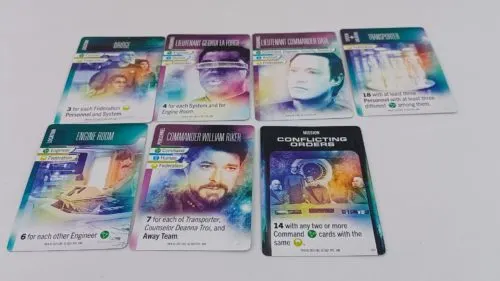Objective of Star Trek Missions
The objective of Star Trek Missions is to acquire a set of cards that complement each other to score more points than the other players.
Setup for Star Trek Missions
- Separate the Galaxy and Mission cards (they have different backs). Shuffle each deck separately.
- Deal five Galaxy cards and two Mission cards to each player. The rest of the cards will form the draw piles for the Galaxy and Mission cards. Players should keep their hands hidden from the other players.
- Choose a player at random to start the game. Players will take turns clockwise throughout the game.

Star Trek Missions Card Anatomy
Each card in Star Trek Missions has five key pieces of information. This information will be used during scoring. These five pieces of information are as follows:
Type: Types in the game include Characters (divided into Captains, Personnel, and Civilians), Locations, Systems, Equipment, and Artifacts. A card’s type is shown in the top left corner of the card.
Specialty: Some of the types of cards have one of more specialties. These specialties include Command, Combat, Science, Medical, Security, Archaeologist, Ambassador, Engineer, Counselor, Weapon, and Cosmic. The Specialty is displayed along the left side of the card below the card’s type.
Lifeform: Many of the cards belong to a type of lifeform. These include Humans, Vulcans, Klingons, Romulans, Ferengi, Betazoids, Androids, Holograms, and others. These will be displayed along the left side of the card below the card’s type.
Affiliation: Many of the cards will align with one of the factions in the Star Trek universe. These include the Federation, Klingon Empire, Ferengi Alliance, Romulan Star Empire, and Hostile. The card’s affiliation will be displayed along the left side of the card below its type.
Text: The most important piece of information on each card is its text section (near the bottom of the card). This section details the special ability that the card provides. It will also tell you how to score points from the card.


Playing A Turn
On your turn you will get to choose one of three actions.

First you can choose to take one of the face up cards from the discard piles. You can choose from any of the cards that have been discarded. After picking up a card, you will have to discard a card from your hand. The card you discard cannot be the card that you just picked up.

Second you can take the top card from the Galaxy deck and add it to your hand. You will then choose one card from your hand to discard.

Your last option is to draw two cards from the top of the Mission deck. You will then choose two cards from your hand to discard.

When you discard cards, you should place them face up on the table and spread out so that all of the players can see them.
You can usually discard any card from your hand that you want. At the end of your turn though you must have one or two Mission cards in your hand. You may not discard a Mission card if it will put you at zero Mission cards. You may also not keep more than two Mission cards at the end of your turn.

After you have drawn a card(s) and discarded the same number of cards, your turn will end. Play will then pass to the next player in turn order.
Star Trek Missions Terms
Much of the game is based on the text printed on the cards. The cards will use a number of terms regularly in the game.
WITH: If a card has a scoring condition that says “WITH”, you may only score that bonus once.

FOR EACH: When a card says “FOR EACH”, you can score the bonus multiple times. You will score the bonus for each card that meets the requirement.

BLANKS: Certain cards will BLANK other cards. When a card has been blanked; it no longer receives any points, give points to other cards, or affects your hand in any other way. The card will still count as one of the cards in your hand though.

BLANKED UNLESS WITH: This card will be blanked unless it meets the requirements listed on the card to avoid being blanked.
End of Game
Star Trek Missions ends when a certain number of cards are in the discard area. The game will end when either eight Galaxy cards or twelve Mission cards are in the discard area. The game will end immediately.

The players will then score all of the cards in their hands.

Star Trek Missions Scoring
Each player will score points for each of the cards in their hand. Each card will be scored individually on the score sheet.
You can use each card in your hand to score points from more than one of the other cards from your hand. You cannot use the same card multiple times for the same card to score multiple times though.







Cards can only affect your own hand. The cards in your hand have no impact on the other players.
You will total the points each player has scored from all of their cards. The player that scores the most points from their cards, wins the game. If there is a tie, the tied players share the victory.

Year: 2022 | Publisher: WizKids | Designer: Bruce Glassco | Artist: NA
Genres: Card, Card Drafting, Set Collection
Ages: 14+ | Number of Players: 2-6 | Length of Game: 20 minutes
Difficulty: Moderate | Strategy: Moderate | Luck: Moderate
Components: 50 Galaxy cards, 24 Mission cards, score pad, instructions
Where to Purchase: Amazon, eBay Any purchases made through these links (including other products) help keep Geeky Hobbies running. Thank you for your support.

